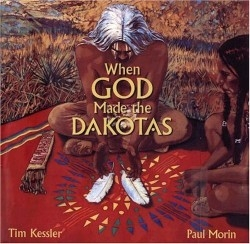
When God Made the Dakotas
It’s late afternoon on the first day of Creation, and Woksape, the medicine man of the Dakota people, is waiting for the Great Spirit to come and fill “the final empty place.” When Wakantanka arrives, he asks Woksape what kind of land he wants for his people. The medicine man asks for “great stone mountains,” and Wakantanka looks in his limp medicine bag, but he has already given mountains to the Shoshone. Woksape requests evergreen forests, but the Great Spirit gave those to the Cree. The Anishinabe have taken “many lakes and a great freshwater sea,” and the Navajo have the “desert beauty and sunshine.”
It seems there’s nothing left for the Dakotas. All that remains in the bag are small hills, a few colored rocks, cottonwood trees, shallow streams, and green grasses. Silent, Woksape “sat down on the rim of the world and gazed at the sun setting on the new world.” Eventually, he tells the Creator that his people trust his generosity: “Give to your people, the Dakotas, whatever you have left to give and it will be good.”
The author, a white North Dakotan, is a seasonal park ranger. He wrote this book, his first, as a Native American legend to convey his love for his native landscape. His language carries the gravity and reverence of one who lives in deep communion with nature, and he includes some Lakota vocabulary, like Tatanka (buffalo) and Maga (goose).
The illustrator has provided art for more than a dozen children’s books, including The Orphan Boy and At Break of Day. Here, the colors of his acrylics (on canvas on cedar stretchers) are as rich and heart-stopping as a prairie sunset. On the abstract pages depicting the two characters sitting in conversation on blankets with authentic designs, Native drawings and symbols are visible in the background.
After Woksape declares his faith, the Great Spirit makes a land from the remains of his depleted medicine bag, imbuing each landscape element with a special spiritual quality. “I will give my smile to the sunset,” he says. He spreads the prairies with grasses, whose waves will resemble the sea. He turns his leather bag into buffalo, which will be the people’s “living medicine bag.” Wakantanka creates sacred clouds, small hills and bluffs, and geese that sing God’s love. “Here, in the broad vastness of the prairies,” he says, “you will always be able to hear me, whispering to your heart and bringing you peace.”
Although the author is not Native American, his creation legend feels authentic, and carries an unusual message: there is astonishing beauty to be found everywhere, even in places—or situations—that seem bleak. The lesson is deeper than simple gratitude; it offers a spiritual approach for all ages to find deep satisfaction in the goodness that is already here.
Disclosure: This article is not an endorsement, but a review. The publisher of this book provided free copies of the book to have their book reviewed by a professional reviewer. No fee was paid by the publisher for this review. Foreword Reviews only recommends books that we love. Foreword Magazine, Inc. is disclosing this in accordance with the Federal Trade Commission’s 16 CFR, Part 255.
